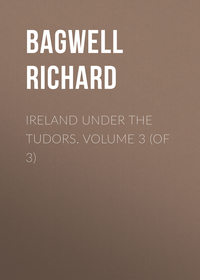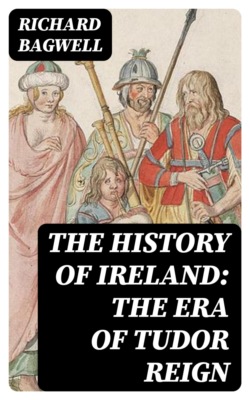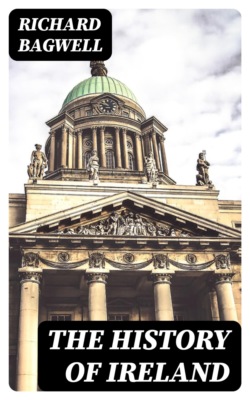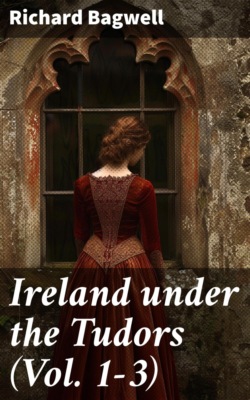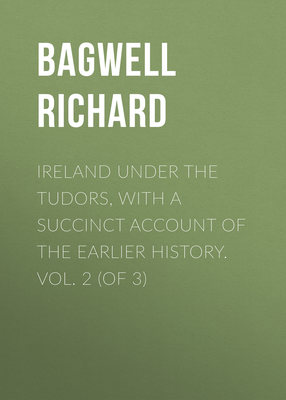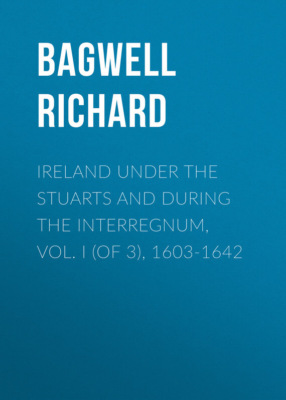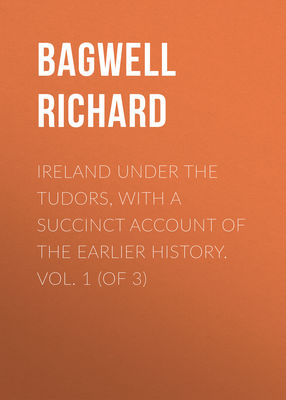Kitabı oku: «Ireland under the Tudors. Volume 3 (of 3)», sayfa 15
Tyrone and Tirlogh Luineach
Tyrone hangs one of Shane O’Neill’s sons, and aims at supremacy in Ulster
The part of Tyrone lying north and west of the Mullaghcarne mountains had been retained by Tirlogh Luineach in 1585, when he agreed to take 1,000 marks a year for the rest. The lease was for seven years, but O’Neill had reserved and wished to exercise the power of taking back the territory in three, which expired at Michaelmas 1588. Fitzwilliam, who had a strong bias in the Earl’s favour, obtained the remaining four years for him, but on condition of paying 300 fat beeves a year in addition to the rent. The two chiefs continued nevertheless to quarrel, and it is curious to note how the English officials sided with Tyrone. The mere fact that he represented the settlement by patent was enough for many of them, and they did not see the danger of making him supreme in the North. Shane O’Neill’s sons were giving trouble, and the ghost seemed more terrible than the reality. Con MacShane had long been a prisoner with Tirlogh Luineach, but was now released and taken into his confidence. A brother, Hugh Gavelagh, who had been two years in Scotland, now returned to Ulster, and was supposed to have incurred Tyrone’s enmity by giving information to the Government. He had promised Perrott to bring over no Scots, and he kept his word; but it was known that he might have plenty if he wished, and his popularity in the North was very great. Hugh Gavelagh was seized by some of the Maguires, sold to Tyrone, and by him hanged on a thorn-tree, and it was reported all over Ireland that the Earl could find no executioner, and had to do the business himself. This he denied, giving the names of the actual operators, and defending his conduct strenuously. Hugh Gavelagh, he said, had murdered many men, women, and children, and there was no regular law in Ulster, ‘but certain customs … and I hope her Majesty will consider that, as her Highness’s lieutenant under the Deputy (as I take myself within my own territory), I am bound to do justice upon thieves and murderers; otherwise, if I be restrained from such-like executions, and liberty left to O’Neill, O’Donnell, and others to use their ancient customs, then should I not be able to defend my country from their violence and wrongs.’ In this sentence we have the whole difficulty of Tudor rule in Ireland briefly expressed. The Government was not strong enough to enforce equal justice, and practically confessed its impotence by allowing authority to lapse into the hands of Tyrone and such as he. From Fitzwilliam downwards, nearly all the officials seemed to think that they could keep things quiet by strengthening a man who aimed at being O’Neill in the fullest sense of the word, but who was quite ready to play at being an earl when it suited him, and to remember his English education. Walsingham saw more clearly from a distance, and wished to make Tirlogh Luineach Earl of Omagh, with an estate of inheritance in his part of Tyrone, and with a superiority over O’Cahan for life. To his rival he was willing to give the rest, including a perpetual superiority over Maguire. But Tyrone was determined to have all, and the men immediately responsible for order found it convenient to support the younger, the abler, and, as it turned out, the more ambitious and dangerous man.207
Rival O’Neills
The MacShanes
In order to understand the history of Ulster during the last decade of Queen Elizabeth, it may be well to define the position of parties there just before Tyrone entered upon his last struggle. Besides the Earl himself, who was for a long time looked upon as the representative of English ideas, and who was probably not an O’Neill at all, there were three families who claimed to be at the head of the ruling race. Tirlogh Brasselagh, Shane O’Neill’s uncle, claimed to be the eldest of the house, and, according to ancient Celtic notions, he had perhaps the best right. His lands lay to the south of Lough Neagh, and he had many sons; but his party was, on the whole, the weakest. Tirlogh Luineach, the actual chief, represented the family of Art Oge, who had long been excluded from the supremacy, and he was thought to hold his position more by force and policy than by right. His eldest son, Sir Arthur, seems not to have been legitimate, but was fully acknowledged as his heir male both by Tyrone and by the Government: his influence was greatest in what are now the baronies of Strabane. The third set of pretenders were Shane O’Neill’s seven sons, known as the MacShanes. Their legitimacy is not worth discussing; but they were favourites with the Irish, and by them generally thought to have the best right. Hugh Gavelagh, Con, and Brian were at this time the most formidable. Tyrone says he made an agreement with Tirlogh Luineach that one of these three should always remain with him as hostage, that Hugh Gavelagh’s neck was specially pledged for its performance, and that the breach was the cause of his death. The other brothers were Henry, Arthur, Edmund, and Tirlogh. With a score or so of fighting O’Neills, all trying to be first, it is not surprising that Ulster was turbulent, or that its reduction by the strong hand was only a question of time.208
Rival O’Donnells
The actual chief of Tyrconnell was Sir Hugh O’Donnell, the husband of Ineen Duive, whose own son, Hugh Roe, was in prison. Donnell, an elder and seemingly illegitimate son, by an Irish mother, was made sheriff by Fitzwilliam in 1588, and was a thorn in Ineen’s side. Calvagh’s son Con died in 1583, but he in turn left nine sons, of whom Nial Garv was the most formidable, and their claims under the patent could hardly be denied. A third set of pretenders were the descendants of Hugh Duff, who were of the eldest blood, and who appealed to Celtic law. But the favourite of the clansmen was young Hugh Roe. All the tribes of the North depended more or less upon O’Donnell and O’Neill, and the lesser chiefries were in dispute as much as the greater.209
Hugh Roe O’Donnell
Kidnapped by Perrott, 1587
There was a prophecy that Ireland should be delivered by the O’Donnells when Hugh succeeded lawfully to Hugh. Its fulfilment was expected in Henry VIII.’s time, and now again it was in men’s mouths. Perrott, who had small regard for such fancies, noticed the boy’s importance, and decided that he would be a good pledge. In the winter of 1587, he sent a ship laden with wine and manned by fifty armed men round to Lough Swilly, where the master, John Bermingham of Dublin, traded freely with the natives. Hugh Roe came to hunt in the neighbourhood, or to visit MacSwiney Fanad, near whose castle of Rathmullen the false merchantman lay. As soon as the strangers heard of his arrival they went on board and kept careful watch. In due course messengers came from MacSwiney, who wanted wine to entertain his distinguished guest. Bermingham answered that he had sold all he had to spare, but would be most happy to entertain MacSwiney and the gentlemen with him. They came on board accordingly, and when they had caroused for some time in the cabin, the seamen quietly got under way, shut down the hatches, and carried the whole party out to sea. Pursuit was impossible, for the natives had no boats; and Hugh Roe was lodged in Dublin Castle, where he found many companions in misfortune, and where prisoners ‘beguiled the time only by lamenting to each other their troubles, and listening to the cruel sentences passed on the high-born nobles of Ireland.’210
First escape of Hugh Roe O’Donnell, 1591
Although not more than fifteen or sixteen years old, Hugh Roe was married to Tyrone’s daughter, and the whole North was thus interested in his safety. Perrott refused 2,000l. for his release, and he remained in prison until Fitzwilliam’s time. His brother Donnell, who married a daughter of Tirlogh Luineach, would have seized the chiefry, had he not been killed in resisting a force raised by Ineen Duive on behalf of her husband and son. Hugh’s fellow-prisoners were hostages from every part of Ireland: among them being Henry and Arthur, sons of Shane O’Neill, and Patrick Fitzmaurice, afterwards Lord of Kerry. The seneschal of Imokilly died in the Castle early in 1589. After more than three years’ confinement, Hugh Roe found means to escape with some of his friends. A wet ditch at that time surrounded the Castle, and the approach was over the wooden bridge, where the Lord Deputy had lately come into collision with the mutineers. The favour, almost amounting to subservience, which Fitzwilliam showed to Tyrone made people think that he was ready to connive at his son-in-law’s escape; but this is very hard to believe. ‘Upon my duty,’ he said when supporting one of the Earl’s numerous applications for Hugh’s release, ‘no reward maketh me write thus much.’ Friendly partisans were numerous in Dublin, and the soldiers who kept the gate always wanted money, and were often under female influences. A rope was conveyed into the Castle, and Hugh slipped on to the bridge in the dusk of evening. The sentry was for the moment inside the gatehouse, and the prisoners managed to chain the gate on the outside. Art Kavanagh, ‘a renowned warrior of Leinster,’ was near with swords hidden under his Irish mantle, and the whole party slipped out of the town, and across the mountains to a wood near Powerscourt. Hugh’s companions here left him, for his shoes had fallen to pieces with the wet, and his feet were lacerated by the furze. Felim O’Toole, the lord of the neighbouring castles, was appealed to; for he had lately visited Hugh in prison, and was supposed to be his friend, the rather that he had married the sister of Feagh MacHugh O’Byrne. Fearing to offend the Government, or believing that escape was hopeless, O’Toole decided to gain credit for loyalty, and he gave up the fugitive, who was taken back to Dublin and loaded with irons.211
Tyrone elopes with Mabel Bagenal, which her brother resents
A plot in private life may have great public consequences, as every generation can testify. The Helen of the Elizabethan wars was Mabel Bagenal, daughter of Sir Nicholas and sister of Sir Henry, whose charms were at least one principal cause of the Ulster revolt. Tyrone had been first married to a daughter of Sir Brian MacPhelim O’Neill, from whom, according to his own account, he was ‘divorced by the orders of the Church.’ As to the validity of this divorce there were certainly doubts at the time, but the repudiated wife married again and had children. Tyrone’s second venture was with an O’Donnell, and he talked of discarding her too, though possibly without intending to do it. She died, and he then fell in love with Miss Bagenal, whom he might see at Newry as often as he pleased. Bagenal would not consent to the match, and his objections had some weight: the possible opposition of the Queen, ‘the incivility of the Earl’s country not agreeing with his sister’s education, and the uncertainty of a jointure to be allotted for her maintenance after the Earl’s death,’ being those which seemed important to the Irish Government. Tyrone was a much more civilised being than Shane O’Neill, and Mabel Bagenal was more accustomed to Irish ways than Lady Frances Radclyffe; but Bagenal hated the proposed alliance as much as Sussex. ‘I can,’ he told Burghley, ‘but accurse myself and fortune that my blood, which in my father and myself hath often been spilled in repressing this rebellious race, should now be mingled with so traitorous a stock and kindred.’ To keep her out of harm’s way, he sent Mabel to her sister, who was married to Sir Patrick Barnewall, and who lived at Turvey near Swords; but Tyrone invited himself to the house for a night, obtained a secret promise of her hand, and presented her with a gold chain worth a hundred pounds. A few days after this he came to Turvey to dine with several friends, and after dinner the young lady slipped away on horseback behind one of them. ‘When I understood,’ he said, ‘that my prey (the language of cattle-lifting) was well forward in her way towards the place where we had agreed upon, I took my leave of Sir Patrick Barnewall and his lady, and followed after, and soon after I was gone, the gentlemen which were in company with me took their horses and came away privately.’212
Tyrone’s marriage, 1591
Tyrone was fifty and Mabel twenty, which makes the romance rather less romantic, and Bagenal may have been right in saying that he did ‘by taking advantage of her years and ignorance of his barbarous estate and course of living, entice the unfortunate girl by nursing in her through the report of some corrupted persons an opinion of his haviour and greatness.’ At all events she probably liked the idea of being a countess. Tyrone’s intentions were so far honourable, in spite of Bagenal’s insinuations to the contrary, and the marriage was celebrated at William Warren’s house near Dublin, by no less a person than the Bishop of Meath, who declared that he was chiefly actuated by regard ‘for the gentlewoman’s credit.’ And, as Tyrone well knew, regard for Bishop Jones’s credit would prevent the marriage from being seriously questioned. But Bagenal’s hostility was unabated, and even in his sister’s presence Tyrone openly declared that he hated no man in the world so much as the Knight Marshal. There is no evidence that he ill-treated her, as Shane ill-treated his victim, but there is some that she was not altogether happy in the wild life which she had chosen, or with her crafty and unscrupulous mate. She died after less than five years of matrimony, and so did not live to see her brother killed in conflict with her husband.213
CHAPTER XLIV.
ADMINISTRATION OF FITZWILLIAM, 1592-1594
Second escape of Hugh O’Donnell, 1592
His sufferings from exposure
He reaches Donegal
It was no new thing that prisoners should escape from Dublin Castle, nor that they should be brought back again; and Hugh Roe did not despair. A year after his first attempt, and at the same evening hour, he knocked off his irons and lowered himself with a long rope into the ditch. His companions were Shane O’Neill’s sons, Henry and Art, and they were helped outside by Tyrone’s confidential servant, Tirlogh O’Hagan. The fugitives passed through the streets unnoticed, and reached the mountains that same night. Their sufferings from exposure were great, and Art O’Neill, who had grown fat in prison, and had besides received a blow from a falling stone when getting out of it, was forced to lie down under a rock at the foot of the mountains. Edward Eustace, who had been sent by Feagh MacHugh to act as guide, was now despatched to that chief, and food and beer were sent to their relief. The men who brought the provisions said that O’Neill was past help, and there he died. Hugh was badly frostbitten and the nails of his great toes afterwards fell off, but he was able to drink some beer, and they carried him to a solitary house in the woods of Glenmalure. In due course Tyrone sent a messenger, with whom he travelled northwards, though he had to be lifted into the saddle and out of it. Felim O’Toole was now eager to help, and accompanied him to the Liffey, which he forded unperceived just above Dublin. His guide spoke English, and led him through Meath to the neighbourhood of Drogheda. Avoiding the town, they diverged to Mellifont, which belonged to Sir Edward Moore, and here they were lodged and helped on their way. After resting until the evening of next day, they rode all night, and passed through Dundalk as soon as the gates were opened in the morning. The danger was now over, and Tirlogh MacHenry O’Neill, whose power lay in the south part of Armagh, forwarded them safely to Dungannon, whence Tyrone sent Hugh O’Donnell, under escort, to Lough Erne. Here he was met by Maguire, and brought in triumph to Ballyshannon. Henry MacShane O’Neill did not go to Glenmalure at all, but escaped northwards from the Dublin mountains, among which his brother had died, and thus fell into Tyrone’s hands. The Earl kept him long in captivity, and it is probable that in helping his son-in-law to escape, he also intended to prevent the Government from setting up the MacShanes against him.214
O’Donnell, Maguire, and Tyrone
Hugh Maguire said that he had given Fitzwilliam 300 cows to free his country from a sheriff, but that one had nevertheless been appointed, in the person of Captain Willis. This officer did not confine his attention to Fermanagh, and much of Tyrconnell was actually in his power. This company, who bore a very bad character in the country, were quartered in the monastery of Donegal, from which they expelled the friars, and Hugh Roe’s first care was to get rid of the intruders. The O’Donnells mustered in large numbers, and Willis and his men were glad to escape with their lives into Connaught. The friars then returned to their house. During March and April Hugh was in the hands of the doctors, who are said to have amputated both his great toes; but in May his father made way for him, and he was installed as O’Donnell with the usual ceremonies. Two expeditions against Tirlogh Luineach followed, and all the country about Strabane was laid waste. Nor was Tyrone quite idle, for he allowed his son Con to attack MacKenna, the chief of Trough, who had profited by Fitzwilliam’s settlement of the MacMahons’ country. The opportunity taken was while MacKenna was attending the sessions at Monaghan, and the commissioners were forced to adjourn. It suited neither O’Neills nor O’Donnells to have sheriffs and gibbets so near them.215
Tyrone induces O’Donnell to submit, 1592
Fitzwilliam proceeded to Dundalk, intent upon making Tyrone give up the offenders, so that they might be hanged at Monaghan, but the outrage turned out to be much less grave than was reported. Anxious to gain a good character, which might be of use to him in arranging his law suits with Tirlogh Luineach, Tyrone went to Donegal, and brought Hugh Roe O’Donnell with him into the Lord Deputy’s presence. Hugh made public submission in the church at Dundalk, swearing to be loyal like his father, and to expel strangers from his country. The result was that all opposition to him ceased in Tyrconnell, since no pretender could hope to cope with a chief who enjoyed the help of the Government.216
Sir John Perrott is accused
His enemies
It has been often said that Sir John Perrott was driven out of Ireland by intrigue, but the fact is that he had long clamoured for his own recall. In England he enjoyed considerable influence, sat as a Privy Councillor, and remained in communication with several men of position in Ireland. But he made enemies everywhere, and it is supposed that the real cause of his downfall was a quarrel with the Chancellor, whom he openly taunted with having danced himself on to the woolsack. ‘Sir John Perrott talked,’ says one biographer, ‘while Sir Christopher Hatton thought.’ He despised the usual and perhaps necessary arts of a courtier, and was too frequently absent from the centre of favour and intrigue. Burghley was certainly his friend, but, great as was the old minister’s power, he could not always prevail against combinations. In Dublin the official set were generally hostile to Perrott, and many had personal grudges against him. He himself attributed his misfortunes to Loftus, whom he had abused for not allowing St. Patrick’s Cathedral to be turned into a college, and Bishop Jones had also his grievances. Philip Williams, Perrott’s secretary, having been dismissed and imprisoned by him, offered to disclose matters affecting the Queen; and it was to the Archbishop of Dublin and Bishop of Meath that he applied for help. Sir Nicholas White, who in some degree represented the old English families of Ireland, as distinguished from the purely English and official element, was favourable to Perrott. His firmest ally was Richard Meredith, a Welshman, who had been his chaplain, and who held the deanery of St. Patrick’s and the bishopric of Leighlin together. Sir Richard Bingham, who had no cause to love Perrott, does not seem to have borne malice; but Fitzwilliam evidently leaned to the side of his accusers. The late Deputy’s language was not only violent, but had that unfortunate quality of picturesqueness which made people remember it. Thus Loftus could tell Burghley, with the certainty of getting corroborative evidence, how his enemy had boasted that he would send the Council out of Dublin Castle on cabbage-stalks, and how he had threatened to pull the Archbishop into small pieces, like grass between his fingers. Such speeches were not treasonable, but they show why so many men were anxious to prove that Sir John Perrott was a traitor.217
Charges against Perrott
The witnesses
Numerous accusations were brought against Perrott soon after his return to England, but he had little difficulty in meeting them. Matters became more serious when a letter purporting to be written by him was actually produced, in which he offered to make Philip II. king of England and Ireland, on condition of being made hereditary Prince of Wales. It seems clear that the paper was forged by Charles Trevor, an adventurer who had been employed by O’Rourke to manage his son’s escape from Oxford, and whom Perrott had formerly imprisoned. His companion in the Castle, and perhaps his accomplice in the forgery, was one Dennis O’Roughan or Roughan, who had originally been a Roman Catholic priest and had lived in Spain. Finding it convenient to return, Roughan professed himself a Protestant, and had several children by Margaret Leonard of New Ross, whom some called his wife and some did not. He was evidently a liar of the first magnitude, for he told Fitzwilliam that he had said mass to Perrott, who was no persecutor, but who was certainly a sincere Protestant and a hater of Spaniards. When Trevor escaped from prison the forged letter, or one like it, remained in his hands, and he seems to have been accused of several of the forgeries and found guilty of at least one. Roughan produced his false letter, and pretended to be in fear of his life from Perrott’s friends. With an evident desire to make the most of it all, the Deputy sent over his son, with orders to give the document to the Queen herself. Bishop Meredith observed that John Fitzwilliam would have to ride very fast if Perrott did not know all before her Majesty. Considering the abundant evidence as to Roughan’s bad character – and he was a perjurer by his own confession – it might be supposed that no credit would have been given to him. Probably much of the truth was kept from the Queen’s knowledge. An enquiry in Dublin had but doubtful results, and the commissioners, whom the Queen herself rebuked, were accused of partiality to Perrott. They examined Roughan, who soon showed his real colours, and they were probably disinclined to do anything on such evidence. When the man went to London, where nothing was known about him, he accused the commissioners of corrupt dealing, but he soon lost credit in England too. Fitzwilliam evidently leaned strongly against Perrott, and Sir N. White was placed under restraint by him. Whether anyone really believed Roughan may be doubted, but the information gained in connection with his story enabled Perrott’s enemies to draw their net round him.218
Trial of Perrott, 1592
He is found guilty, though probably innocent
At the beginning of February, 1591, Sir John Perrott was in the custody of the Lord Treasurer; and of his friends we are told that the Bishop of Leighlin was merry in the Fleet, and Sir Nicholas White sad in the Marshalsea. Contrary to the expectation of many, Sir John was sent to the Tower on March 8; and there he was destined to end his days. His imprisonment was close, and he complained of impaired memory from the treatment he received. At last, in April 1592, he was brought to trial for treason, his indictment specifying that he had compassed the Queen’s death. On one side were Popham, Egerton, and Puckering, and on the other a rough old knight, conscious of many rash speeches, but strong in the confidence which innocence gives, and ‘renouncing the merits and mercy of his Saviour Jesus Christ’ if he was really guilty. The court did nothing to supply the want of counsel. Chief Justice Anderson behaved with his usual brutality, declaring that Perrott was worse than Babington or than any of the traitors, and they were many, at whose trials he had assisted. Hunsdon was one of the Commission, and he also interfered very often and very unfairly. The accused could do little but protest that he was innocent, and that Roughan and Williams were perjured scoundrels. He wished the devil might take him body and soul if he had uttered a certain coarse speech, which many thought the real cause of Elizabeth’s animosity. He appealed to Rokeby, master of requests, who was one of his judges, whether his experience in Ireland had not taught him that witnesses there had no respect for an oath and might be cheaply bribed to swear anything. God, he said, would plague his persecutors for their corrupt dealing. He was found guilty, but a great judge of our own time has described his trial as ‘the scandalous attempt of prerogative lawyers – of which Elizabeth herself was ashamed – to convert the peevish speeches against her, of that worthy old soldier, Sir John Perrott, into overt acts of high treason.’219
Death and character of Perrott
‘Sir John Perrott,’ says Swift, ‘was the first man of quality whom I find upon the record to have sworn by God’s wounds. He lived in the reign of Queen Elizabeth and was supposed to be a natural son of Henry VIII. who might also probably have been his instructor.’ According to Naunton, who is not a bad authority on such a point, Perrott was aware of his royal parentage. ‘What,’ he asked the lieutenant of the Tower, with oaths and fury, ‘will the Queen suffer her brother to be offered up a sacrifice to my skipping adversaries?’ Naunton shows that circumstances make the fact not improbable, and adds that Perrott’s manners, appearance, and voice were like those which the Elizabethan tradition ascribed to Henry. Hatton, the chief of Sir John’s skipping adversaries, was now dead; and the Queen was urged by Burghley and others to spare a faithful, though rash, servant. At all events she refused to sign his death-warrant, and when his speech to Hopton was reported to her, she swore by God’s death that they were all knaves. It was thought that she intended to pardon him, and she was often heard to applaud a rescript of Honorius, ‘that if any person speak ill of the Emperor through a foolish rashness and inadvertency, it is to be despised; if out of madness, it deserves pity; if from malice and aversion, it calls for mercy.’ Perrott died in the Tower in the following September; but his chief request was granted, and his son was allowed to inherit. The fact of that son being married to Essex’s sister may have had something to do with this.220
Tirlogh Luineach O’Neill resigns the chiefry in Tyrone’s favour, 1593
The disputes between Tyrone and Tirlogh Luineach were hard to settle, for the several grants were not easily reconcilable with one another. But Coke’s opinion was taken, and that great lawyer laid down that, by virtue of an indenture made in 1587, the Earl might be forced to leave Tirlogh and his son in quiet possession of such lands as should be awarded to them by inquisition. This had been practically a condition of reviving the earldom in Hugh’s person, and the older grant of all Tyrone by Henry VIII. was so far modified by it. As to the lands, Fitzwilliam effected an arrangement nearly in accordance with Coke’s opinion; but Tirlogh was now old, and finding himself unable to resist both Tyrone and O’Donnell, he thought it wiser to resign his chiefry in his rival’s favour. ‘Hugh O’Neill, namely the Earl,’ say the Four Masters, ‘was then styled the O’Neill, and Tirlogh Luineach, having made peace with O’Neill and O’Donnell, sent away the English whom he had with him. This was done in May 1593. Ulster was then under the peaceable government of these two; and they had hostages of the inhabitants in their power, so that they were subject to them.’221
The Four Masters’ notions of peace
A titular archbishop
Tyrone’s object for the movement was to keep things quiet and to gain credit for loyalty; but neither he nor O’Donnell ever enjoyed much of the peaceable power described by the annalists. Brian Oge O’Rourke had a dispute with the Binghams about his composition rent, and plundered the country about Ballymote. Maguire’s emulation was aroused, and, in spite of a promise to Tyrone, he also invaded Connaught, leaving Lough Allen to his left, and penetrating to Tulsk in Roscommon, where Sir Richard Bingham was encamped. The English party were outnumbered, and Maguire drove off many cattle, but, in the running fight which followed, Edmund MacGauran, titular primate of all Ireland, was killed. According to Bingham, MacGauran was constantly occupied in stirring up sedition, which he fostered by assurances of Spanish aid. ‘He was, he says, ‘a champion of the Pope’s, like Dr. Allen, the notable traitor; but, God be thanked, he hath left his dead carcase on the Maugherie, only the said rebels carried his head away with them that they might universally bemoan him at home.’ O’Sullivan said that the Archbishop had special orders from Philip II. to stir up war against the Protestants, and to hold out hopes of Spanish succours, and that Maguire was sorry for his loss rather than pleased at the spoil which he was able to secure.222
Maguire attacks Monaghan, but is defeated by Tyrone, who soon changes sides
O’Rourke kept Bingham pretty busy during the summer, and Maguire turned his attention to Monaghan. It was not difficult to raise a party among the MacMahons, and Monaghan was vigorously attacked early in September. The garrison repulsed the assailants, but not without considerable loss, and Fitzwilliam found it necessary to make a great display of force. Bagenal and Tyrone commanded the troops, which were collected at Clones, and Maguire drove off his flocks and herds into Tyrconnell. The fords over the Erne near Belleek were found indefensible against so strong a force, but Tyrone was severely wounded in the thigh. This victory of the brothers-in-law only increased their mutual hatred, for the Marshal claimed most of the credit, which the Earl thought belonged to him. The O’Neills were engaged in large numbers, and the tactics which afterwards proved so fatal to Bagenal had been employed on his side. ‘Maguire’s assailants,’ says O’Sullivan Bere, ‘had 700 horse against 100, and musketeers against archers, and the leaden bullets went further than the arrows. The musketeers in the woods bordering on the river shot down with impunity the Catholics who stood in the open, while the archers could take no aim at men protected by thick clumps of trees.’ The same writer says that Bagenal asked Tyrone to write in praise of his valour both to the Queen and to the Deputy, and that the Earl replied that he would tell the truth when he came into their presence. It was one of Tyrone’s grievances that Bagenal got more than his due share of credit, but it is probable that this was mainly an excuse for the course upon which he had already determined. According to O’Sullivan, O’Donnell was on his way to help Maguire, but was delayed by a messenger from Tyrone, who begged him not to compromise him while in the power of the Protestants, whose party he was about to desert. Tyrone believed, or pretended to believe, that the Marshal had orders from Fitzwilliam to arrest him; and, wounded as he was, he withdrew to Dungannon, out of harm’s way. This was his last service to the Crown during Elizabeth’s life, and the annalists believed that it was rendered unwillingly.223
